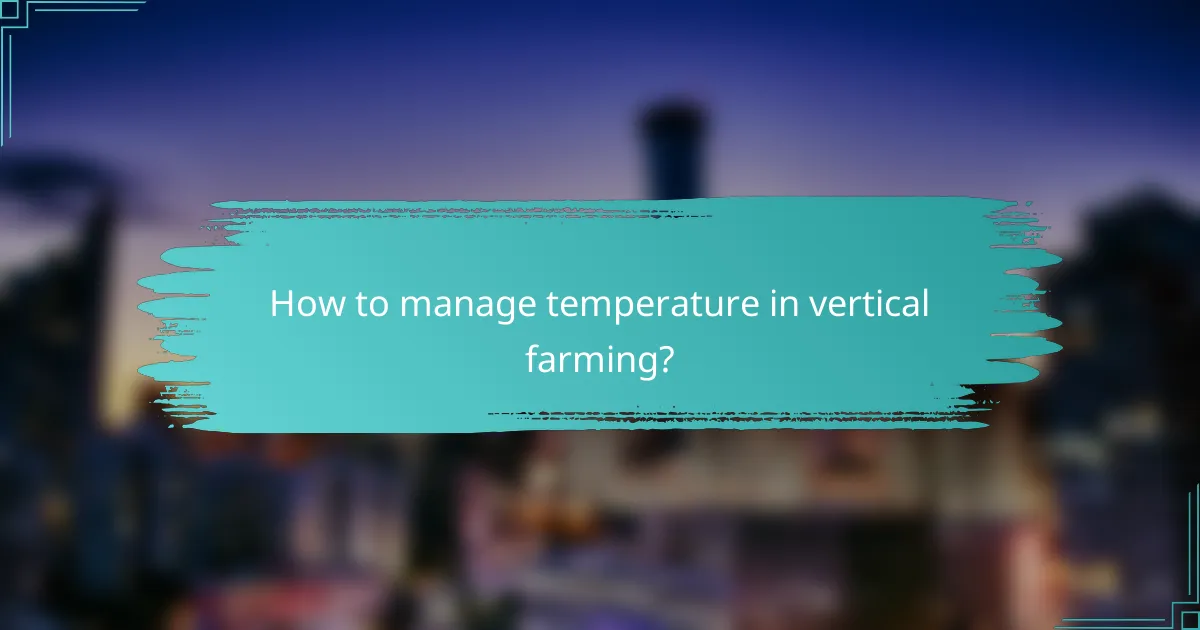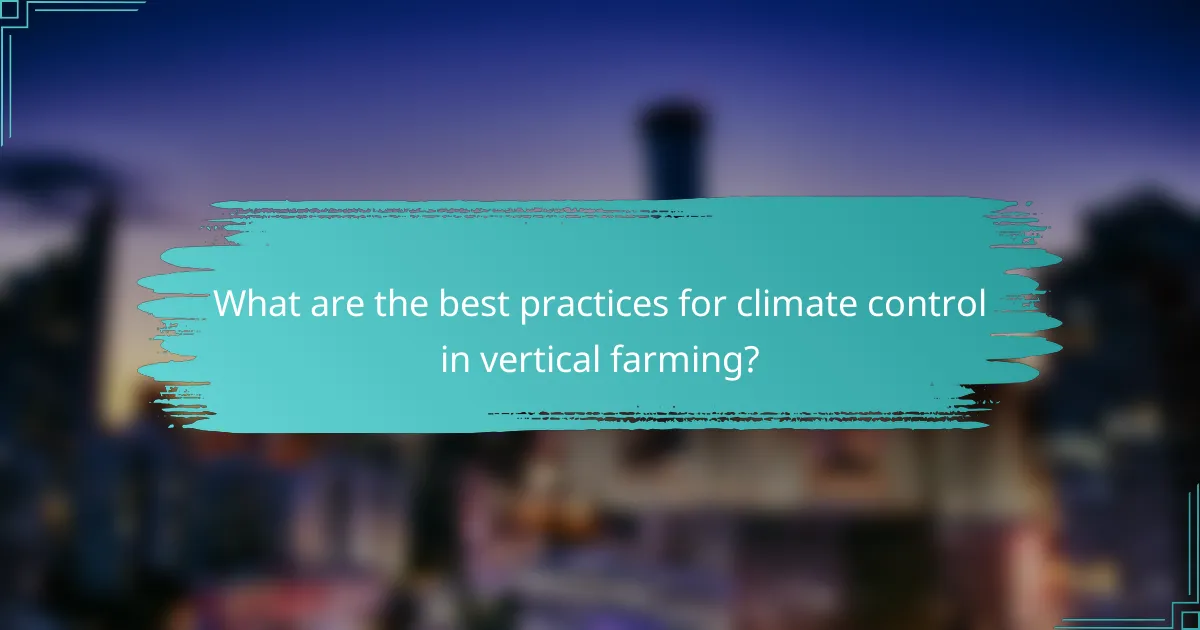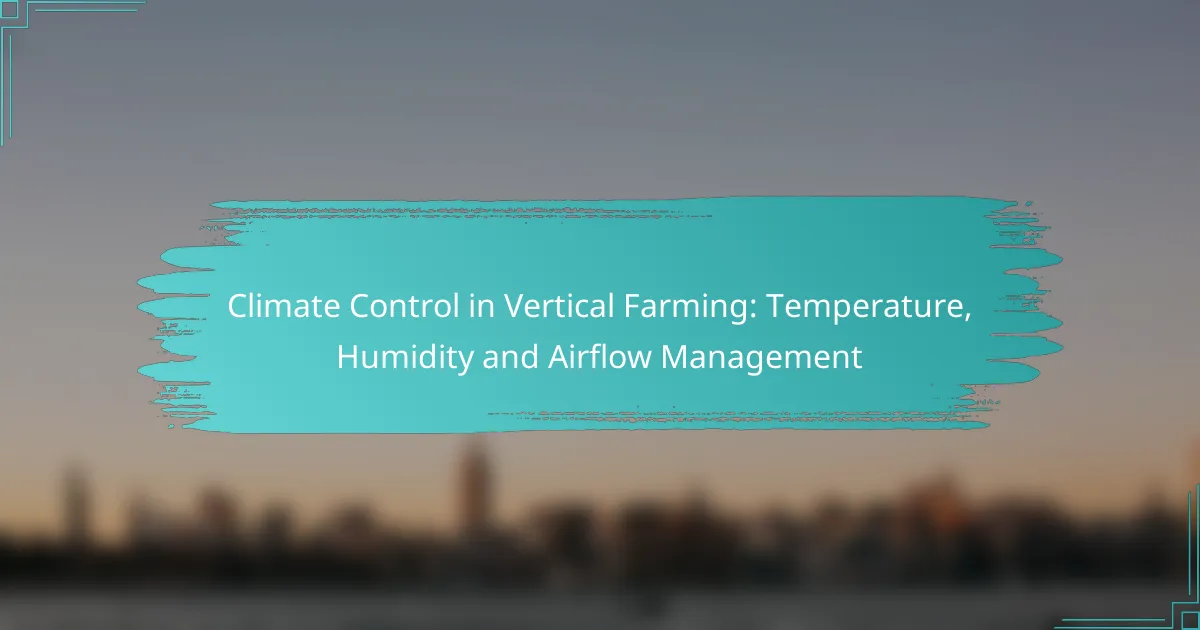Effective climate control in vertical farming is essential for maximizing plant growth and yield. This involves carefully managing temperature, humidity, and airflow to create optimal conditions for various crops. By maintaining ideal temperature ranges and humidity levels between 50% and 70%, and ensuring proper airflow, vertical farms can enhance plant health while minimizing disease risks and pest issues.

How to manage temperature in vertical farming?
Managing temperature in vertical farming is crucial for optimizing plant growth and yield. Effective temperature control involves using technology and strategies to maintain ideal conditions for various crops throughout their growth cycles.
Use of climate control systems
Climate control systems are essential for regulating temperature in vertical farms. These systems often include heating, ventilation, and air conditioning (HVAC) units, as well as sensors that monitor temperature fluctuations. Automated systems can adjust conditions in real-time, ensuring a stable environment for crops.
Investing in advanced climate control technology can lead to significant energy savings and improved crop quality. For example, using programmable thermostats allows farmers to set specific temperature profiles for different growth stages, enhancing efficiency.
Optimal temperature ranges for crops
Different crops have varying optimal temperature ranges that influence their growth and productivity. Generally, most leafy greens thrive between 18°C and 24°C, while fruiting crops like tomatoes prefer slightly warmer conditions, around 20°C to 26°C. Understanding these ranges helps in setting up the climate control systems effectively.
Maintaining temperatures within these optimal ranges can prevent stress on plants, which can lead to poor yields or diseases. Regular monitoring and adjustments are necessary, especially during seasonal changes or when using supplemental lighting.
Impact of temperature on plant growth
Temperature significantly affects plant physiological processes, including photosynthesis, respiration, and nutrient uptake. High temperatures can accelerate growth but may also lead to stress, wilting, or reduced quality. Conversely, low temperatures can slow growth and increase susceptibility to pests and diseases.
To mitigate these risks, farmers should implement strategies such as shading or cooling systems during heat waves and heating systems during colder periods. Understanding the specific temperature needs of each crop can help in maximizing growth and minimizing losses.

What humidity levels are ideal for vertical farms?
Ideal humidity levels for vertical farms typically range from 50% to 70%. Maintaining this range helps optimize plant growth and minimizes the risk of diseases.
Recommended humidity ranges for different crops
Different crops have varying humidity requirements. For instance, leafy greens like lettuce thrive at around 60% to 70% humidity, while herbs such as basil prefer slightly lower levels, around 50% to 60%. Fruits and flowering plants may require even more precise control, often needing humidity levels between 55% and 65% during their growth stages.
Effects of humidity on plant health
Humidity significantly impacts plant health by influencing transpiration rates and nutrient uptake. High humidity can lead to mold and mildew, while low humidity may cause wilting and stress. Striking the right balance is crucial for maximizing yield and quality.
Humidity control technologies
To manage humidity effectively, vertical farms often employ technologies such as dehumidifiers, humidifiers, and advanced HVAC systems. These systems can be automated to adjust humidity levels in real-time based on sensor data. Regular monitoring and maintenance of these systems are essential to ensure optimal performance and prevent fluctuations that could harm crops.

How to optimize airflow in vertical farming?
To optimize airflow in vertical farming, ensure that air circulates effectively throughout the growing environment. Proper airflow supports plant health by facilitating respiration, reducing humidity levels, and preventing the growth of mold and pests.
Importance of airflow for plant respiration
Airflow is crucial for plant respiration as it helps deliver carbon dioxide and remove oxygen from the growing area. Adequate air exchange is necessary for photosynthesis and overall plant vitality. Without sufficient airflow, plants may experience stunted growth and increased susceptibility to diseases.
In vertical farming systems, maintaining optimal airflow can enhance nutrient uptake and improve crop yields. Plants typically thrive in environments where air movement mimics natural conditions, promoting healthy growth patterns.
Methods for enhancing airflow
Several methods can enhance airflow in vertical farming setups. One effective approach is to use fans strategically placed to create a consistent air movement throughout the growing area. Oscillating fans can help distribute air evenly, preventing stagnant zones.
Another method involves designing the layout of the farm to facilitate airflow. For instance, spacing plants adequately and using vertical racks can improve air circulation. Additionally, incorporating vents or ducts can help manage airflow more effectively.
Airflow management systems
Airflow management systems are essential for maintaining optimal conditions in vertical farms. These systems can include automated fans, sensors, and climate control software that adjusts airflow based on real-time data. Such systems help maintain consistent temperature and humidity levels, which are vital for plant health.
Investing in a quality airflow management system can lead to significant improvements in crop quality and yield. When selecting a system, consider factors such as energy efficiency, ease of integration, and the specific needs of the crops being grown.

What are the best practices for climate control in vertical farming?
Effective climate control in vertical farming involves managing temperature, humidity, and airflow to create optimal growing conditions. Best practices include integrating these elements seamlessly, utilizing advanced monitoring technologies, and automating systems for efficiency.
Integration of temperature, humidity, and airflow
Integrating temperature, humidity, and airflow is crucial for maintaining a stable environment in vertical farms. Temperature should typically range between 20-25°C for most crops, while humidity levels are best kept between 50-70% to prevent mold and promote healthy growth.
Airflow management is essential to ensure even distribution of temperature and humidity. Use fans and vents to create a consistent air exchange, which helps prevent hot spots and maintains uniform conditions. Regularly assess and adjust these parameters based on plant growth stages.
Monitoring and automation technologies
Implementing monitoring and automation technologies can significantly enhance climate control in vertical farming. Sensors for temperature, humidity, and CO2 levels provide real-time data, allowing for quick adjustments to maintain optimal conditions.
Automated systems can control HVAC units, irrigation, and lighting based on sensor feedback. This not only saves energy but also reduces labor costs. Consider integrating systems that allow remote monitoring and management for added convenience and efficiency.

What are the costs associated with climate control systems?
The costs associated with climate control systems in vertical farming can be divided into initial investments and ongoing operational expenses. Understanding these costs is crucial for budgeting and ensuring the sustainability of the farming operation.
Initial investment for climate control systems
The initial investment for climate control systems typically includes purchasing equipment such as HVAC units, dehumidifiers, and sensors. Depending on the scale of the vertical farm, these costs can range from several thousand to tens of thousands of USD.
Factors influencing the initial investment include the size of the facility, the complexity of the system, and the desired level of automation. Investing in high-quality, energy-efficient systems may lead to lower operational costs in the long run.
Operational costs of maintaining climate control
Operational costs for maintaining climate control systems encompass energy consumption, routine maintenance, and potential repairs. Energy costs can vary significantly based on local electricity rates and the efficiency of the equipment used.
Regular maintenance is essential to ensure optimal performance and can include filter replacements, system calibrations, and inspections. Budgeting for these ongoing costs is critical, as they can account for a substantial portion of the overall operational expenses in vertical farming.

How to choose the right climate control system?
Selecting the right climate control system for vertical farming is crucial for optimizing plant growth and resource efficiency. Consider factors such as temperature, humidity, and airflow management to ensure a productive environment.
Factors to consider in selection
When choosing a climate control system, assess the specific needs of the crops you intend to grow. Different plants thrive under varying temperature and humidity levels, so understanding these requirements is essential. For instance, leafy greens generally prefer cooler temperatures, while fruiting plants may need warmer conditions.
Energy efficiency is another critical factor. Systems that utilize renewable energy sources or advanced technologies like variable speed fans can significantly reduce operational costs. Look for systems that offer programmable settings to adjust conditions based on time of day or growth stages.
Finally, consider the scalability of the system. As your vertical farm expands, the climate control system should be able to adapt without requiring a complete overhaul. Modular systems can be a good choice, allowing for incremental upgrades as your needs evolve.
